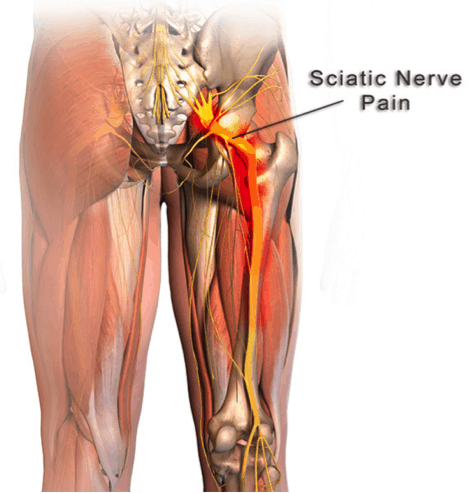“Sciatica”, you may have come across this term several times in conversations with people around you, on the internet, and whatnot. But what exactly is it? Are you, in the off chance, a sufferer of this ailment? What triggers Sciatica and what causes and it? Let’s find out!
Contents
- 1 What is sciatica?
- 2 What are the symptoms of sciatica?
- 3 What causes sciatic nerve pain?
- 4
- 5 What triggers sciatica?
- 5.1 Stressing yourself out
- 5.2 Practicing poor posture
- 5.3 Wearing ill-fitting clothes
- 5.4 Sitting for long durations with hard objects stored in the back pocket
- 5.5 Wearing high-heeled shoes without cushion
- 5.6 Being overweight
- 5.7 Bending over to lift heavy objects
- 5.8 Practicing a sedentary lifestyle
- 5.9 Experiencing pregnancy
- 5.10 Going through depression and other negative emotions
- 6 How is sciatica nerve pain diagnosed?
- 7 Is sciatica curable?
- 8 Which natural treatments can give relief from sciatica?
- 9 How do I get my sciatic nerve to stop hurting?
- 10 When does sciatica become serious?
- 11 Sciatica Treatment
- 12 Frequently Asked Questions
What is sciatica?
Many times, people mistake sciatica with general back pain. This is incorrect and misleading. Sciatica is the term used for the irritation of the sciatic nerve which is the longest and widest nerve in the human body that runs from the lower back, through the buttocks, and down the legs, all the way to the knees. The pain that’s caused by this nerve’s irritation can range from mild to severe.
The Sciatic Nerve
Several muscles in the lower leg are controlled by this nerve. This nerve is also responsible for creating a sensation at the skin of the foot and the major part of the lower leg.
Sciatica is less of a condition and more of a symptom of another problem that’s caused involving the sciatic nerve. According to surveys conducted by experts, 40% of adults will experience sciatica at least once in their lives. Sciatica is most commonly caused as a symptom of a slipped or herniated disc.
What are the symptoms of sciatica?
Sciatica symptoms are as follows:
- Shooting pain anywhere along the sciatic nerve, from the lower back, through the buttocks, and down the rear area of each leg.
- A sensation of numbness in the leg.
- A sensation of pins and needles or tingling in the feet and toes.
- There are reports that patients may also experience a sudden jolt of electricity in the lower back or legs
- Difficulty in walking, standing or sitting
These symptoms may manifest any time between a few weeks to a couple of years. Though, it is important to notice that not everyone will experience the same symptoms as sciatica feels different for each individual.
What causes sciatic nerve pain?
Sciatic nerve pain is, at 90% times, caused by a slipped or herniated disk. To understand this better, you have to know that the spinal column is made up of 3 parts:
- The vertebra, that’s made up of the individual bones in the spine. Its function is to protect the underlying nerves.
- The nerves
- The disks
Disks are made up of a strong and resilient substance called cartilage which acts as a Sciatica cushion between each layer of the vertebra. This allows your spine to be flexible. A slipped or herniated disc takes place when a disc is pushed out of its place. This puts a whole lot of pressure on the nerve, which consequently causes sciatic nerve pain.
Sciatica nerve pain is also caused by:
- Lumbar spinal stenosis which is the narrowing of the spinal cord in the lower back
- The spondylolisthesis is where the disc slips in front of the vertebra
- The tumors within the spine may cause the sciatic nerve to compress
- Any injury within the spine
- Cauda equina syndrome is a serious condition that can gravely impact the nerves in the lower part of the spine
The risk of developing sciatica pain is high in the following circumstances:
- Aging
- Poor functioning of the body
- Practicing poor posture
- Being overweight
- Suffering from trauma or injury in the lower back
- Straining your body by playing too much of sports
- Smoking
- Pregnancy or childbirth
- Inheritance of spine abnormalities
- Tumours in the spine, any spinal injury such as slipped or herniated disc, infection in the spine, disorders that may be affecting the spine
What triggers sciatica?
What triggers sciatica varies from person to person. For some people, there may not be one but many reasons that come under the list of what causes sciatica to flare up. It is important to know what causes sciatica to flare up as it will help you in preventing and controlling the pain.
Sciatica may get triggered due to the following reasons:
Stressing yourself out

Practicing poor posture
The practice of poor posture or the body not being aligned properly can create stress on the sciatic nerve. When that nerve gets irritated, sciatica symptoms become evident.
Wearing ill-fitting clothes
Tight-fitting clothes such as jeans and ill-fitting elastic undergarments come under the list of what causes sciatica to flare up. This is because of the pressure that’s put by such clothes on the sciatic nerve.
Sitting for long durations with hard objects stored in the back pocket
Sitting for a long time with hard objects like a phone, wallet, keys, etc. can irritate the piriformis muscle. The sciatic nerve is located under the piriformis muscle, which will consequently get irritated too. The person will experience shooting pain.
Wearing high-heeled shoes without cushion

Being overweight
According to research, the more you weigh, the more pressure you put on your sciatic nerve. This is one of the major elements in the list of what triggers sciatica. And so, it is important to keep a check on your weight which will go a long way with your sciatica.
Bending over to lift heavy objects
Each time you pick up your toddler, carry huge amounts of groceries or try to move around pots in the garden, a lot of weight and pressure is being exerted on your lumbar discs. Each time your lumbar discs feel overstressed, you are at a huge risk of developing a herniated disk. This, in turn, becomes a factor in what triggers sciatica.
Practicing a sedentary lifestyle
Individuals practicing a sedentary lifestyle by sitting without any interruptions are more likely to develop sciatica than individuals who regularly exercise. This is because sitting for long durations can cause damage to the intervertebral disks. This can, in turn, become a factor in what triggers sciatica.
Experiencing pregnancy

Going through depression and other negative emotions
Stress is actually known to trigger any pain and not just sciatica pain. According to research conducted by scientists across the globe, body pain can be induced whenever there are repressed emotions and feelings.
How is sciatica nerve pain diagnosed?
If the sciatica symptoms do not last long and last up to a maximum duration of 4 to 8 weeks, you are probably suffering from acute sciatica which does not need much medical attention.
The diagnosis could be speeded up if the patient’s medical history is available. Individuals may also be required to perform basic exercises in order to stretch the sciatic nerve. If there is shooting pain occurring while the individual performs these exercises, the individual is probably suffering from sciatica.
If the pain is lasting beyond 4 to 8 weeks, then it’s probably best for the individual to go through image testings, such as X-ray or MRI scans which will help in understanding what exactly is causing irritation to the sciatic nerve.
Is sciatica curable?
Even though the pain caused by sciatica may seem pretty daunting, the good news is that it is curable. It may seem challenging but it is possible for anyone suffering from this condition to reduce the pain to the point of getting rid of the pain completely.
Once the individual gets the required help from physicians to identify the cause of sciatica, they can look into the array of treatments available. A majority of people suffering from sciatica benefit from natural treatments. Just after a few sessions of natural treatment, the individual can rest free from being symptom-free of sciatica.
Which natural treatments can give relief from sciatica?
Several natural treatments are non-invasive and work for the benefit of the patient. Read on to know which ones are.
Exercise

Although exercise is very beneficial, it is important for you to maintain caution. Make sure you consult your physician or doctor before you start sweating it out.
Using hot and cold packs
Both hot and cold packs can provide a great amount of relief to anyone suffering from sciatica. The effect of using both of these different packs is different as they work at different levels. Cold packs and Essential nerve pain oils can give relief from the pain as it helps in reducing any inflammation or swelling that may be compressing the sciatic nerve.
Heat packs help in relaxing and losing the taut muscles of the lower back.
Deep breathing
Practicing deep breathing will help in making alpha brain waves active. This helps in calming the brain and, in turn, reduces anxiety or stress levels. The alpha brain waves are also beneficial in releasing beta-endorphins or brain chemicals that act as natural relievers of pain.
Practicing yoga
It’s been proven that practicing stretching and yoga can benefit greatly individuals suffering from the condition. By strengthening the back, the practice of yoga can soothe and decrease the flare-ups of sciatica.
Using posture correctors and supporters of the back
According to research, as discussed above, practicing the wrong posture can lead to many back issues, not just sciatica. Whenever the sciatic nerve is impinged or irritated in any way sciatica occurs. Each time your spine is misaligned, you put pressure on the sciatic nerve. To prevent the misalignment of the spine, use posture correctors or lumbar back supports that would keep your spine in place.
Practicing progressive muscle reaction
This is a widely used relaxation technique for muscles. It is also known as Jacobson’s progressive muscle reaction and even deep muscle reaction. In this technique, the muscles are relaxed, then gradually tensed for a short duration, and then completely relaxed.
When muscle groups everywhere are relaxed, that’s when the entire body is relaxed. The goal to achieve is to cope with stress in a better manner which, in turn, will prevent the sciatic nerve from getting irritated.
Cognitive-behavioral therapy
This is a particularly helpful way to reduce the stress and anxiety caused in patients by focusing on their thoughts and emotions. This is essential in preventing acute back pain from turning into chronic back pain.
How do I get my sciatic nerve to stop hurting?
Let’s get more specific and talk about practicing which exercises can help in sciatica treatment.
The reclining pigeon

- As you lay on your back, bring your right leg up to a right angle. Hold your hands and lock your fingers from below the thigh.
- Raise your left leg and put your right ankle over the knee of your left leg.
- Hold yourself in this position for at least a minute. This is beneficial in stretching the piriformis muscle, which can, at times, become inflamed and affect the sciatic nerve.
- Now repeat this exercise with the other leg.
As you’re able to perform this exercise with no pain, you can start working with your physical therapist on practicing the different versions of this pose.
The sitting pigeon
- Get yourself seated on the floor with your legs stretched out in front of you.
- Bring your right leg up to your right ankle by bending it and put your right ankle on top of the knee of your left leg.
- Now make yourself lean forward as you try to reach your thigh with your upper body.
- Hold yourself in this position for at least 15 to 30 seconds. This is beneficial in stretching out your glutes.
- Repeat this on the other side of your body.
Forward pigeon
- Bend down on the floor till you’re on all fours.
- Pick your right leg up and move it in front of your body. Your right foot should be in front of the knee of the left leg. This should occur with your right knee staying to the right all the while you do this.
- Stretch your left leg out behind yourself and point your toes all the way back.
- Now very gradually try shifting the weight of your body from your arms to your legs so that the legs act as the support for the entire body weight.
- Hold yourself in this position and now try shifting your weight to your upper body.
- Repeat this on the other side
Knee to the opposite shoulder

- As you lay on your back, extend your legs and stretch your feet upwards.
- Bend your right leg and hold your hands together around the knee
- Now gently pull your right leg towards your left shoulder.
- Make yourself stay in this position for at least 30 seconds and only extend your leg across your body till the point it is comfortable.
- You should experience a relieving feeling and not pain through this exercise.
- Repeat this same exercise with the other leg and the opposite shoulder.
Stretching your spine via sitting
We’ve learned that sciatica pain is only triggered once the vertebrae in the spine get compressed. Practicing this exercise can help in stretching the spine, which in turn will create space in your vertebra.
- Make yourself sit on the ground with your legs outstretched in front of you and your feet directed upwards.
- Now bend your right knee and place the right foot over the floor on the side of the left half of your body.
- Try placing your left elbow on the side of your right knee. This will help in gently turning your body towards the right side.
- Hold yourself in this position for at least 30 seconds, and repeat it a minimum of three times. Switch over to practicing this exercise on the other side.
Stretching your hamstring by standing
This exercise will help in easing out the tightness you may be feeling in your hamstring.
- First, place your right leg at a level below your hip or any elevated surface such as a staircase or a chair.
- Now bend your body forward towards your foot. Do not push yourself too far so that you feel pain.
- After this, release the hip downwards of the leg that you’ve lifted up. You can use a yoga strap or an exercise band to do this better.
- Make yourself stay in this position for at least 30 seconds and then continue to practice this exercise on the other side.
When does sciatica become serious?
If you feel the following then your sciatica may most likely be demanding serious medical attention because it may indicate serious conditions such as cauda equina syndrome, infections, or even spinal tumors.
- Increasing neurological weaknesses, for instance, leg weakness
- Discomfort in both legs
- Dysfunction occurring in the bowel and the bladder
- Sexual dysfunction
Sciatica Treatment

- Ibuprofen, naproxen, or other non-steroidal anti-inflammatory drugs
- Prednisone or other oral steroids
- Gabapentin or other anticonvulsant drugs
- Amitriptyline or other antidepressants
- Tramadol or other opioid analgesics
Opioid analgesics are taken in very short durations in order to prevent addiction to the drug.
Chiropractic therapy
This is a kind of therapy that comes under the list of sciatica treatments. It is a type of manual manipulation that is performed on the patient’s body by the chiropractor. It is particularly helpful for people suffering from slipped or herniated discs or spinal stenosis. It is not meant to be painful and only focuses on giving the patient relief from pain.
Massaging
The pros of participating in massage therapy are as follows:
- Speeding and improvement of blood circulation will create better healing in the body from whatever irritation or discomfort
- Relaxing taut muscles throughout the body
- Releasing endorphins which function as natural pain relievers
Injections
There are several types of injections available that can reduce the pain caused by sciatica and provide relief to a large extent. Apart from providing relief, the injections are also essential in diagnosing the issue better and identifying the target areas and nerves of sciatica.
- Lumbar therapeutic injection: This helps in targeting the areas where the pain stems from and provides relief to those areas.
- Epidural steroid injection: This particular injection helps patients suffering from slipped discs and spinal stenosis by controlling the inflammation around the sciatic nerve. It also contributes to hindering the immune system from producing inflammatory cells.
- Nerve root injection: This injection is given near the spinal nerve as it exits the intervertebral foramen. The injection targets the nerve and numbs the sensation that runs through it.
It is important to note that not everyone will experience these injections in the same manner. While some may experience pain relief at an immediate rate for a long time, some may experience only short-lived relief and others may experience no relief from the pain at all.
Surgery
If the sciatica pain persists for more than 4 to 8 weeks even after identifying what triggers sciatica in the patient’s body and going through medications and natural non-invasive treatments, then it’s probably best for the patient to go through the options of surgery. Let’s survey the different options of surgery available.
- Microdiscectomy: This is considered to be a very common option for people suffering from slipped or herniated discs. The surgery is done to remove a small part of the nerve root of the disc. Even though this is an open surgery, it is targeted at being minimally invasive and can be carried out with just a little incision and the least amount of tissue damage.
- Laminectomy: This surgery focuses on removing a part of the lamina or even the entire lamina in order to provide more space for the spinal nerves. This is a surgery that’s commonly carried out in patients suffering from sciatica pain that’s caused by spinal stenosis. This is very helpful in pain relief as the spinal nerves finally have some space to breathe.
- Foraminotomy: Bony overgrowths from the neuroforamen are removed; this helps in providing more space to the nerve root that exits the spine through the neuroforamen.
- Facetectomy: In this surgery, facet joints are either trimmed or removed to provide relief to the nerves that were being otherwise suppressed by the facet joints.
According many types of research conducted across the globe, it’s suggested that surgery has been far more effective and reducing pain and providing sustained pain relief to people suffering from sciatica pain compared to non-invasive treatments.
The person suffering from sciatica pain can make the decision to undergo surgery due to the following reasons:
- Amount of pain
- Dysfunction in several body parts and aspects
- Duration of the pain
- Overall health
Now that we’ve learned so much about sciatica, let’s delve into some commonly asked questions regarding sciatica.
Frequently Asked Questions
Q: What does sciatica feel like?
A: The discomfort caused by sciatica can be felt at any point along the sciatic nerve. It’s more likely to be felt in your buttocks and lower back with pain that can range anywhere from mild to excruciating.
Q: Why is sciatica pain the worst in the morning?
A: The pain caused by sciatica is at its worst in the morning for most people because of the position they sleep in. If you lie in the wrong position, that may irritate your sciatic nerve further and cause more pain.
Q: Which side should one sleep on to reduce sciatica pain?
A: According to research, it’s probably best for the person suffering from sciatica to sleep on their side and not on their back. They can place a pillow between their thighs or legs which may help in reducing the pressure caused on the spine.
Q: How do I get my sciatic nerve to stop hurting?
A: Through the above-discussed exercises and non-invasive natural treatments one can prevent their sciatic nerve from hurting too much. If the pain still persists after trying out all these different ways, it’s probably best for the patient to undergo surgery as discussed above according to their diagnosis.
Q: Are sciatica and herpes zoster related?
A: No, the two conditions are not related to each other in any way. However, the herpes zoster does mimic the symptoms of sciatica which makes the diagnosis of the condition hard.
Q: What aggravates sciatica?
A: Changes in the spine related to age and obesity are one of the many elements that come under the list of what aggravates sciatica. To know more about what aggravates sciatica, weigh the factors discussed above that may be causing your sciatic nerve to be irritated.
Q: Can stretching aggravate sciatica?
A: Although you’ve probably heard that stretching will only help in reducing the pain caused by sciatica. There are some stretching exercises that people suffering from sciatica should avoid performing. They may affect the sciatic nerve in a harmful way and irritate it further. So stick to only practicing the stretching exercises discussed above.
Q: Can sciatica be caused by constipation?
A: There are many different causes of sciatica, as discussed above. And constipation, although highly unlikely, is one of them. If the bowels of a person are distended due to any constipation, there would be pressure being applied on the sciatic nerve which will, in turn, cause sciatica.
Q: Can sciatica cause pain in the heels?
A: Yes, there can be pain caused in the heels due to the irritation in the nerve root related to the heel taking place in the spine.
Q: Are sciatica and plantar fasciitis related?
A: Yes, sciatica is related to plantar fasciitis. A person suffering from plantar fasciitis, which is a pain in the heels, can also be suffering from sciatica. This is because the nerve roots are being pinched in the spine due to sciatica.
Q: Are sciatic and multiple sclerosis related to each other?
A: While it is easy to mistake the symptoms and conditions of multiple sclerosis with those of sciatica, the two are, indeed, not related to each other.
Q: What triggers Sciatica nerve Pain?
A: Sciatica pain is triggered by stress, bad posture, tight-fitting clothes, wearing high heels, sitting constantly for a long duration, etc.
Let’s hope this article has proven to be useful to you in knowing about what triggers sciatica and all that there is to know about sciatica.

Hi, I am Valerie. I love working out and trying out various products which help me maintain my fitness. I love reviewing products related to posture and pain relief that will help people in some way. I like to spend my extra time swimming, Running and Wall Climbing. I am a physiotherapist and have helped countless people lead a pain free life.





